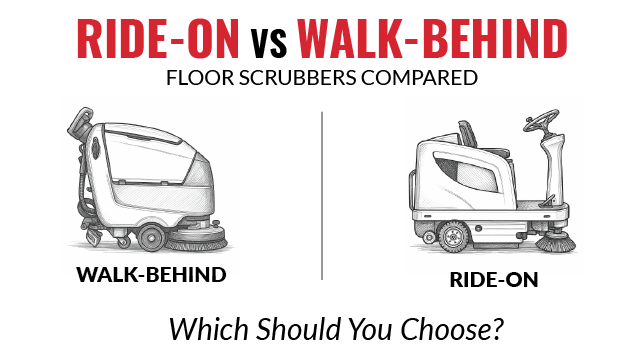When it comes to keeping commercial and industrial floors clean, choosing the right floor scrubber can make all the difference in efficiency, cost, and overall cleanliness. With so many options available, it’s easy to overlook the importance of matching your equipment to your facility’s specific needs.
The two most common types—ride-on and walk-behind floor scrubbers—each offer unique advantages depending on the size of your space, cleaning frequency, and budget.
In this guide, we’ll compare ride-on vs. walk-behind floor scrubbers in detail to help you determine which solution is the best fit for your operation.
Let’s dive in!
What is a Ride-On Floor Scrubber?
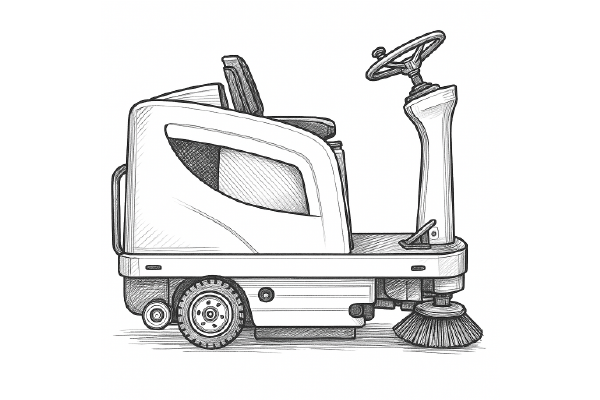
Ride-on floor scrubbers are large, vehicle-style machines operated by a seated driver. Designed to clean expansive areas quickly, they feature wide cleaning paths (20–48+ inches) and large clean/recovery water tanks for long, uninterrupted commercial cleaning cycles.
Common Applications:
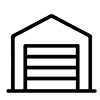
Warehouses

Distribution Centers
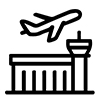
Airports

Universities

Hospitals
Pros:
- High cleaning productivity: Clean tens of thousands of square feet per hour.
- Reduced operator fatigue: Ergonomic seating minimizes strain.
- Heavy-duty deep cleaning power: Higher brushes pressure tackles grime and stains.
- Fewer interruptions: Larger tanks and longer battery life to reduce downtime.
Cons:
- Higher upfront cost: Typically $8,000–$25,000+.
- Bulky machine size: Needs wide aisles and space to maneuver.
- Training required: A more complex control panel.
- Storage requirements: Requires larger dedicated space.
What is a Walk-Behind Floor Scrubber?
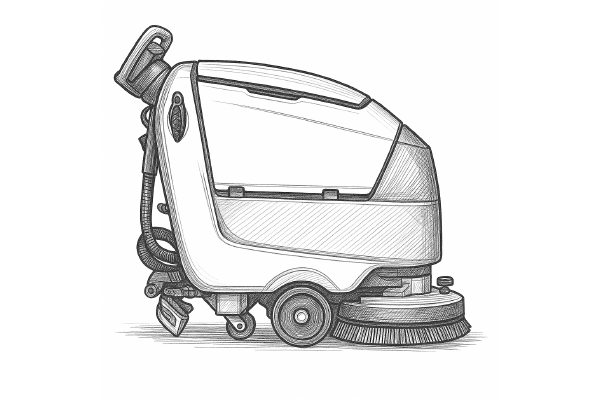
Walk-behind floor scrubbers are compact machines guided by an operator. Most are self-propelled and offer precise control for smooth floors and tight spaces.
Common Applications:

Small Businesses

Office Buildings

Schools & Daycares

Healthcare Facilities

Retail Stores
Pros:
- Lower cost: $3,000 – $10,000.
- Highly maneuverable: For tight turns and floor surfaces.
- Easy to use and store: Some can fit in closets.
- Lower maintenance: Simpler scrub system.
Cons:
- Slower cleaning: Especially in large areas.
- More effort: Requires walking and steering.
- Frequent refills: Smaller water flow/recovery tank.
- Limited handling: Struggles with large debris.
Ride-On vs. Walk-Behind: Detailed Comparison
Efficiency and Productivity
Ride-ons clean faster than walk-behind units thanks to broader cleaning paths and higher speed. For example, an Advance SC6500 can boasts up to 96,800 sq. ft. per hour of cleaning coverage. The greater coverage stems from both a wider cleaning path and less time spent stopping to refill tanks or change batteries (ride-ons have larger capacities).
Walk-behind scrubbers, on the other hand, are perfectly efficient for smaller or segmented spaces. In areas under roughly 20,000–30,000 square feet, a quality walk-behind can often clean within a normal work shift and meet the facility’s needs. However, in large facilities these machines tend to slow down as the operator tires on long routes.
When to Use
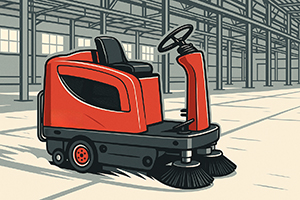
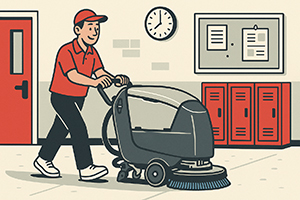
Maneuverability and Ease of Use
Walk-behind scrubbers are generally more nimble and easier to maneuver in confined spaces. They come in various sizes (some with cleaning widths as small as 14–17 inches) and can easily fit through standard doorways and congested areas.
In terms of ease of use, walk-behind scrubbers are typically straightforward to operate. Basic models have simple controls – often just switches for the brush, vacuum, and forward motion. New employees can usually be trained quickly on a walk-behind since it feels similar to using a commercial push mower or vacuum.
Ride-on scrubbers, while larger, have improved significantly in maneuverability with modern designs. Many ride-on models feature a tight turning radius and power steering. Some compact ride-on units can even navigate surprisingly small corridors. However, as a rule, you need to ensure your facility’s layout can accommodate the footprint of a ride-on. Check aisle widths and turning spaces: a ride-on might require a wider turning aisle and won’t fit into narrow nooks.
Ride-on machines involve a higher level of operator training. Drivers must learn to steer, accelerate, and brake the machine safely, and to be aware of the scrubber’s dimensions when turning or passing through tight spots. That said, many ride-ons now have user-friendly features like one-touch scrubbing controls and automatic braking.
Another aspect of ease of use is operator comfort. Here, ride-on scrubbers have an advantage for long duration cleaning: the operator sits on a padded seat, often with back support, and doesn’t have to walk or push.
When to Use
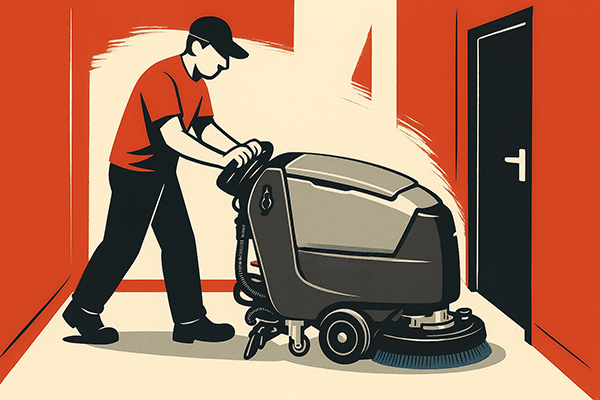
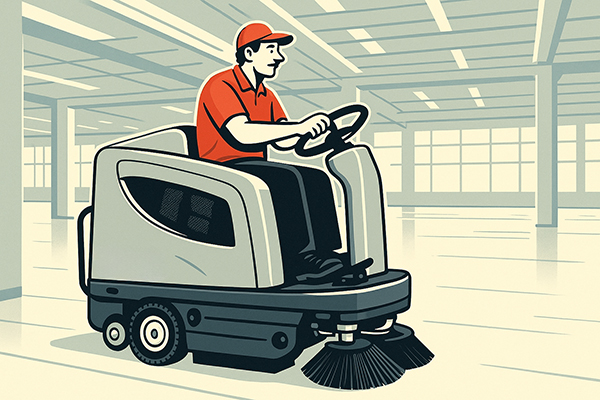
Cost Considerations
Budget is often a deciding factor in the ride-on vs. walk-behind debate. There is a significant cost difference between these types. Walk-behind floor scrubbers generally have a much lower initial price. Ride-on scrubbers are a bigger investment – high-end autonomous or combination sweeper-scrubber units can cost even more. These figures will vary by brand and specifications, but as a rule, expect to pay substantially more for a ride-on unit of equivalent scrubbing width.
| Cost Factor | Walk-Behind | Ride-On |
|---|---|---|
| Initial Investment | $3,000–$10,000 | $8,000–$25,000+ |
| Maintenance | Low | High |
| Labor | High | Low |
| Storage | Compact | Requires space |
In terms of long-term ROI, a ride-on scrubber can deliver strong returns in large facilities. The reduction in cleaning hours (and possibly fewer cleaning staff required) generates labor savings that accumulate every day. Those savings can outweigh the financing or purchase cost of the machine relatively quickly.
For a smaller facility, a walk-behind likely makes better financial sense – the lower purchase price and adequate performance means you avoid over-investing in capacity you don’t need.
When to Use
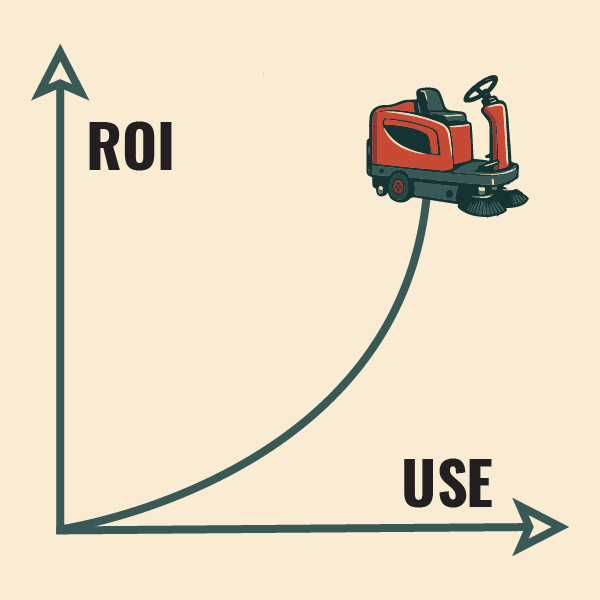
Cleaning Power and Performance
In terms of cleaning results, both ride-on and walk-behind scrubbers operate on the same principles – they use rotating brushes or pads, water and detergent, and a vacuum squeegee to scrub and dry floors.
However, there are some performance differences to note:
Ride-on scrubbers tend to be built for heavy-duty performance. They often have multiple brushes or wider scrub decks that can apply more down pressure overall. Some large ride-ons have higher brush motor power and can carry extra brushes (for example, a rider might have two counter-rotating cylindrical brushes or dual disk brushes side by side, whereas a small walk-behind may have only one disk). This means ride-ons can tackle tough dirt and bigger messes more efficiently in one pass.
If you have a facility with frequent heavy soil, grease, or grime (e.g. an industrial plant or warehouse with forklift traffic), a robust ride-on scrubber might clean more deeply and consistently due to its weight and brush pressure.
That said, many walk-behind scrubbers offer commercial-grade cleaning performance as well, especially the mid-size and larger walk-behind units. They can generate plenty of scrubbing friction on standard dirt and scuff marks – for example, disc scrub decks on walk-behinds are known for good down pressure to remove scuff.
On delicate floors (like certain coated floors or smaller decorative areas), a walk-behind offers more control and perhaps less risk of any accidental damage, since the operator is closer to the work and the machine is lighter.
In summary, a ride-on might edge out in performance for extremely large, dirty jobs with its power and continuous operation. A walk-behind offers equivalent cleaning quality on a smaller scale and might be the better tool for detailed or fragmented cleaning areas. Often, facilities will use a combination: a ride-on for big open zones and a couple of walk-behinds for edges or small rooms, leveraging the strengths of each.
When to Use
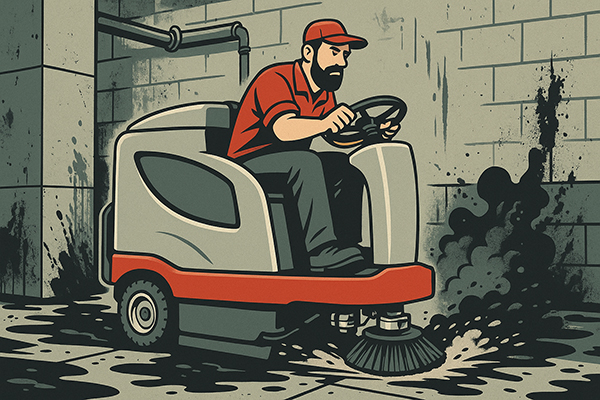
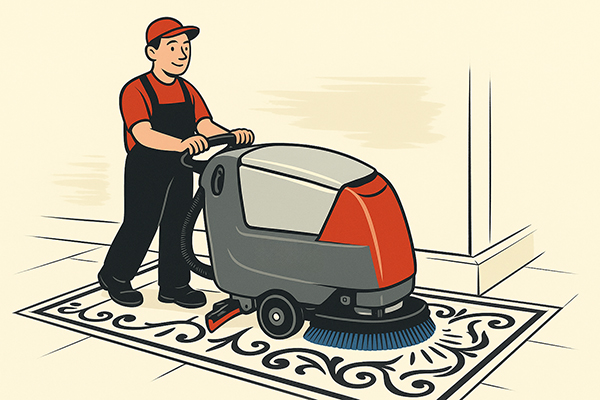
Space and Storage Needs
Be sure to consider the space requirements for each type of scrubber, both in use and when stored.
Ride-on scrubbers are physically larger machines – akin to the size of a small riding lawn tractor or golf cart. You will need adequate storage space for the unit, ideally a dedicated area where it can be parked, cleaned, and charged (for battery models) when not in use. Facilities with equipment rooms, maintenance shops, or large storage areas can usually accommodate this.
In tighter facilities, however, finding floor space for a ride-on could be a challenge. Walk-behind scrubbers, especially smaller models, take up much less room – they can often fit in a janitorial closet or against a wall in a warehouse. If you have limited storage, a walk-behind is easier to tuck away.
When to Use
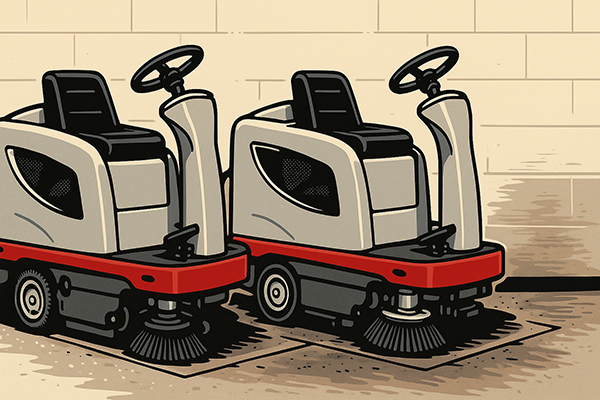
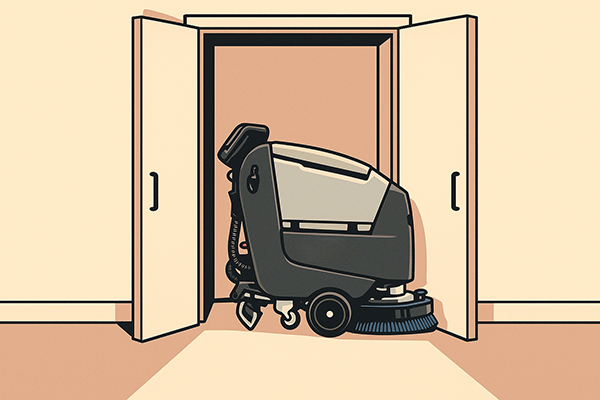
Safety and Ergonomics
Both ride-on and walk-behind scrubbers are far safer and more ergonomic for workers than old-fashioned mopping – they virtually eliminate the repetitive bending, wringing, and manual effort, and they leave floors dry which reduces slip hazards. But there are some distinctions in safety and ergonomics between the two types:
As noted, ride-on scrubbers let the operator sit, which greatly minimizes physical strain. There is no constant walking or pushing effort. The operator is sitting up higher and the machine’s front may obscure some view directly in front of the brushes. That’s why ride-ons often include mirrors or cameras for backing up, and the operator must be trained to be aware of the machine’s front and side clearance. Still, the elevated position on a ride-on can be beneficial for visibility in large open areas, allowing the driver to see further ahead and have a broad view of their surroundings.
Some ride-ons come with flashing warning lights or backup alarms to alert pedestrians, which is a safety plus in busy facilities.
On a walk-behind, the operator is directly behind the scrub deck, with a clear view of the path immediately in front. This can make it easier to see small obstacles or spills and to ensure edges are cleaned. However, vibration and handle height are considerations. If used for shorter, periodic cleaning, a walk-behind’s ergonomics are usually fine. But for hours of continuous use, a ride-on offers a more fatigue-free experience.
Walk-behinds allow better visibility and control in crowded places and are generally simple and have few moving parts exposed, so risks are minimal. The main safety considerations are to avoid tripping on cords (for corded models) and to follow proper handling of batteries and chemicals (e.g. wearing gloves when changing batteries or adding detergent).
Ride-on scrubbers offer superior ergonomic comfort and, when used in appropriate areas, can be very safe. Walk-behinds offer close-quarters control and simplicity which can be advantageous in tight spots. Both will improve overall safety by drying floors quickly, thus preventing slips – a major source of workplace injuries.
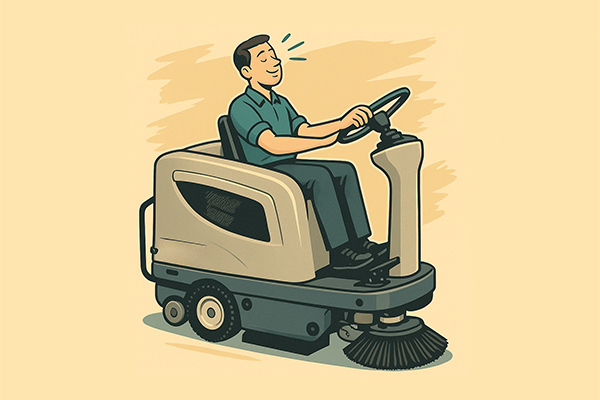
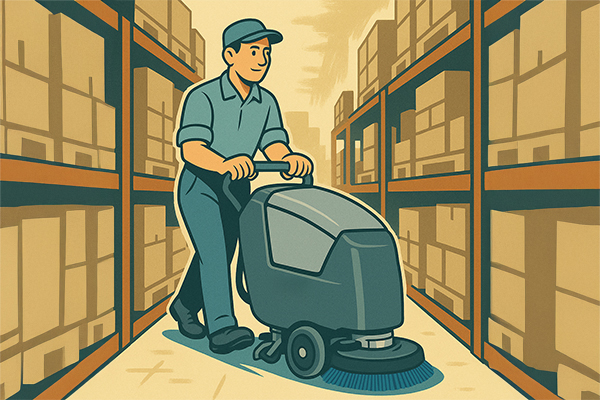
Who Should Choose a Ride-On Floor Scrubber?
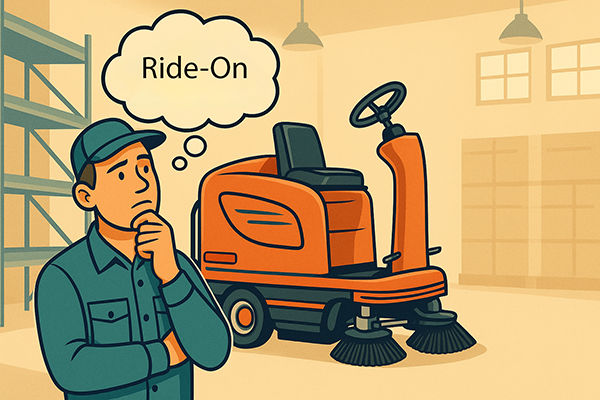
Choosing a ride-on floor scrubber is typically best for those who manage large facilities or high-traffic, expansive spaces. If you have extensive floor square footage to clean regularly – for instance, a warehouse, manufacturing plant, airport concourse, shopping mall, or big retail store – a ride-on will dramatically increase efficiency.
As a rule of thumb, facilities larger than about 50,000 sq ft of open floor space are strong candidates for ride-on machines.
Choose ride-ons for
- 50,000+ sq. ft. of floor
- Open layouts
- Lowering labor costs
- Faster, frequent cleaning
- Trained operators
- Industrial floor cleaning
Who Should Choose a Walk-Behind Floor Scrubber?
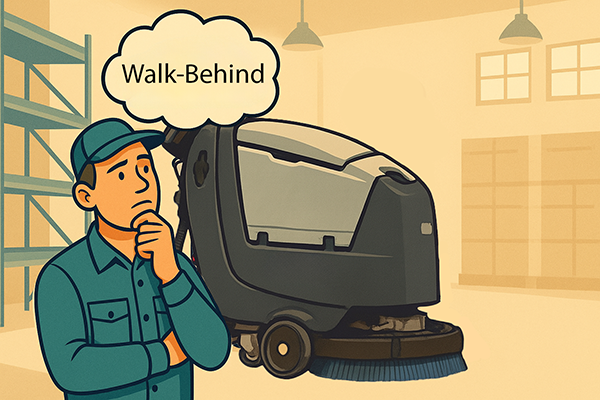
A walk-behind floor scrubber is an excellent choice for small and medium facilities or those with tight layouts. If your cleaning areas are relatively compact – for example, a retail store, school, clinic, restaurant, or small warehouse – a walk-behind can likely cover the space effectively without the extra cost of a rider. Walk-behind scrubbers are also ideal for facilities with narrow aisles, doorways, or lots of obstacles. Think of a supermarket with closely spaced aisles, or a workshop with equipment and workbenches on the floor – maneuvering a ride-on in those scenarios could be impractical, whereas a walk-behind can weave through with ease.
Choose walk-behinds for
- <50,000 sq. ft.
- Tight layouts
- Smaller budget
- Regular use
- Multi-shift or mobile teams
Key Questions to Ask Before Choosing
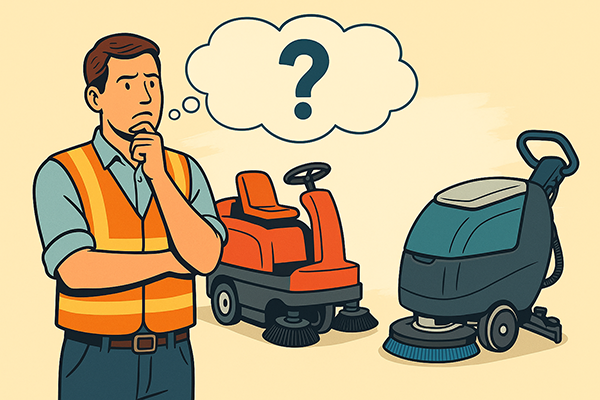
How large is the area (or areas) you need to clean?
Calculate the square footage and the layout. Very large, wide-open areas lean toward a ride-on, while smaller or segmented areas lean toward a walk-behind.
What is the layout of your facility?
Are there narrow aisles, tight corners, doorways, or cluttered spaces? If yes, a walk-behind might navigate better. If your layout is open with broad aisles, a ride-on will have room to operate.
How often and how quickly do you need to clean the floors?
Daily or multi-shift cleaning of large areas often justifies a ride-on for efficiency. If you only scrub periodically or have plenty of time for one person to use a walk-behind, that could suffice.
What is your budget for equipment and maintenance?
Beyond just the purchase price, consider long-term costs. Can you afford the higher upfront cost of a ride-on, and will the labor savings repay it? Or is a smaller investment in a walk-behind more realistic for now?
Do you have trained staff (or the ability to train someone) to operate a ride-on?
Operating a ride-on is easy with training, but you’ll want a reliable operator. If staffing is high-turnover or you prefer a plug-and-play approach, a walk-behind might be simpler.
Where will you store and charge the machine?
Ensure you have sufficient space and the appropriate charging infrastructure especially for a ride-on. If space is limited, check the dimensions of walk-behind models to find one that fits your storage area.
Are there any facility constraints?
For example, if you have multiple floors without an elevator, you may need multiple machines or a portable unit. Or if your floors include steep ramps, ensure the chosen scrubber can handle the grade (some ride-ons have powerful motors for ramps, and some walk-behinds might struggle on slopes).
Conclusion
Both commercial floor scrubbers solve different problems. For fast, battery powered, efficient cleaning, ride-ons are the best floor scrubber for large-scale use. For small, busy, or budget-conscious settings, walk-behind floor scrubbers are a solid choice.
Need help choosing the right scrubber? Conger Conger is here to help. Contact us at Conger.com to explore our entire scrub line up and find the system that meets your needs.
